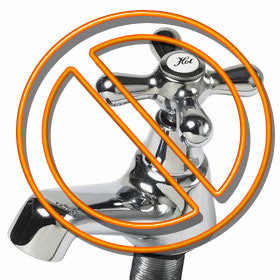A Leaky Faucet can Cause Lack of Sleep, and Waste up to 5 Gallons of Water per Day.
by Jamie & Kelson Carter, Father/Son, Carter's My Plumber
Can you imagine not
having a faucet in your home? Where
would you brush your teeth? Wash your
face? How about that fresh glass of
water?? Faucets are such a valuable part of a home structure, and keeping them
in a good working condition is imperative.
A leaky faucet causing a “drip,
drip, drip” noise is not only disturbing to sleep but adds to the water bill and
causes inconvenience that might range from annoying to catastrophic.
So, what causes a faucet to drip? The cause can be corrosion, mineral deposit on
the internal parts, or defective gaskets, O-rings, or washers. Ignoring a faulty
faucet can turn a simple repair into a major plumbing replacement project. Did
you know a single faucet drip can drip 5 gallons of water per day? That equates to 41 baths per year!
Not only is that bad for the environment, but the wasted water
will cost you.
1.Here are the Facts!
According
to the United States Environmental Protection Agency; “On an average, leaks can
cause almost 10,000 gallons of wastage in a home every year, and this amount is
sufficient to fill a swimming pool. The most common issues of leakage are
dripping faucets, leakage in toilet flappers, or leaking valves, all of which
can be easily fixed. However, among these, the most prominent leakage issue is
caused by a dripping faucet; fixing one can save almost 10% of a homeowner’s
water bill.”
2.What causes a Faucet to Drip?
There
may be several causes why a faucet is drips. Here is a list of some major
causes:
1. Problem with the O ring – A stem screw holds the handle of a faucet in place. This stem
screw is made up of a small disc attached to it, known as the O ring, which is
an integral point where dripping can occur. The O ring, which is a rubber
material, may become loose or wear out with regular usage, causing the faucet
to drip near the handle. Replacing the damaged O ring will fix the dripping
faucet, if this is the issue, and this problem occurs specifically in cartridge
faucets.
2. Corroded Valve Seat – A valve seat is the connection between the faucet and the
spout in a compression mechanism. Accumulation of water sediments can cause the
valve seat to corrode and cause leakage around the spout area. Make sure to
clean the valve seat regularly, with the help of a professional plumber.
3. Worn out Washer – Definitely one of the most common causes behind a dripping
faucet. During each use, the washer is forced against the valve seat. This
constant friction and resistance causes the valve to wear out. As a result,
dripping starts around the spout. A worn
out rubber washer in a compression faucet can be stopped by replacing the
washer.
4. Improper installation of Washer – If the washer is not installed properly or
is not the right size, it will cause leakage. Seek professional help in installing the
washer correctly, and this will take care of the leakage problem.
5. Loose Parts – The adjusting ring and packing nuts in the stem screw may
become loose with continuous usage, causing leakage near the handle of the
faucet. If there is leakage from the handle, either packing nut needs tightened
or replaced.
6. Worn out Seals – Inlet and outlet seals are a vital part of disc faucets. With
constant usage, sediment can accumulate inside the assembly, and cause the seal
to wear out. This causes a faucet to
drip. Hire a plumber to clean the water
sediments regularly from the inlet and outlet seals to make sure that the
faucet mechanism works properly. Replace the seals for better faucet function.
7. Broken Plumbing – On occasion, a dripping faucet may be caused by a broken pipe
or fittings. Broken pipes develop cracks that can interfere with water pressure
and lead to faucet dripping. If none of the solutions above have solved the
dripping faucet issue, hire an experienced plumber to check the water pipes.
Understanding
why a faucet is leaking is crucial to fixing it properly and fixing the drip will
save sleep and money over time! Call Carter's My Plumber if you need advice, or a professional plumber: 317-859-9999
 Hot Water is more likely to leach the heavy metal from your plumbing pipes. In 1986 using solder for pipe joints was banned, however, brass plumbing parts might contain a bit of lead as well. Today Plumbing parts legally considered lead-free may contain up to 8% lead. This means chances are you don't have lead-free plumbing.
Hot Water is more likely to leach the heavy metal from your plumbing pipes. In 1986 using solder for pipe joints was banned, however, brass plumbing parts might contain a bit of lead as well. Today Plumbing parts legally considered lead-free may contain up to 8% lead. This means chances are you don't have lead-free plumbing.














